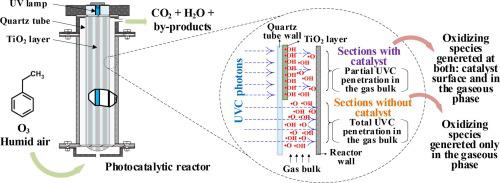Separation and Purification Technology ( IF 8.1 ) Pub Date : 2021-01-16 , DOI: 10.1016/j.seppur.2021.118344 Larissa Albuquerque Silva Saldanha , Nilza Tatiane das Graças Santos , Edson Tomaz

|
Over decades heterogeneous photocatalysis has been successfully applied to degrade a wide range of pollutants. Despite it, when aromatic volatile organic compounds (VOCs) are treated, generally, challenges such as low efficiency and photocatalyst deactivation are faced. In this scenario, the association between heterogeneous photocatalysis and ozone (TiO2/UV/O3) has emerged as an alternative to overcome such issues, although it has not yet been applied to ethylbenzene removal from gaseous streams. In this work, gas-phase ethylbenzene degradation (73 ppmv) by UV radiation, O3, UV/O3, TiO2, TiO2/UV, TiO2/O3, and TiO2/UV/O3 processes was evaluated. The influence of parameters such as relative humidity (26–80%), space-time (130, 74, 52, and 29 s), ozone concentration (3.6, 4.2, and 5.5%), and percentage of catalytic coating area (50, 70, 90, and 100%) on ethylbenzene removal was investigated. Relative humidity from 26 to 50% did not affect ethylbenzene degradation significantly and TiO2/UV/O3 enhanced its removal up to 87.7% and 22% when compared to the TiO2/UV and the UV/O3 processes, respectively. A maximum ethylbenzene conversion of 98% was also reached at 130 s, 70% of TiO2 coating area, and 5.5% of ozone. We found that, in the TiO2/UV/O3 system, reactions on the catalyst surface and in the gas bulk were both important, thus a 70% of TiO2 coating area was obtained as the best configuration. Furthermore, catalyst stability was assessed by a time-on-stream experiment and TiO2/UV/O3 maintained the average ethylbenzene conversion at 75% during 50 h. TGA/DTGA and FTIR analyses allowed the identification of possible compounds adsorbed on the catalyst surface after reactions.
中文翻译:

在不同催化涂层面积百分比下,与臭氧(TiO 2 / UV / O 3)有关的光催化乙苯降解:工艺参数评估
数十年来,非均相光催化已成功地用于降解各种污染物。尽管如此,当处理芳香族挥发性有机化合物(VOC)时,通常面临诸如低效率和光催化剂失活的挑战。在这种情况下,非均相光催化与臭氧(TiO 2 / UV / O 3)之间的关联已成为克服此类问题的替代方法,尽管该方法尚未应用于从气流中去除乙苯的工作。在这项工作中,UV辐射,O 3,UV / O 3,TiO 2,TiO 2 / UV,TiO 2 / O 3和TiO 2引起的气相乙苯降解(73 ppmv)评估/ UV / O 3工艺。诸如相对湿度(26–80%),时空(130、74、52和29 s),臭氧浓度(3.6、4.2和5.5%)和催化涂层面积百分比(50)等参数的影响(分别为70%,90%和100%)。与TiO 2 / UV和UV / O 3工艺相比,相对湿度从26%增至50%不会显着影响乙苯降解,并且TiO 2 / UV / O 3的去除率分别提高至87.7%和22%。在130 s,70%的TiO 2涂层面积和5.5%的臭氧下,也达到了98%的最大乙苯转化率。我们发现,在TiO 2 / UV / O 3中在系统中,催化剂表面和气体中的反应都很重要,因此,最佳配置可获得70%的TiO 2涂层面积。此外,通过运行时间实验评估催化剂稳定性,并且TiO 2 / UV / O 3在50小时内将平均乙苯转化率保持在75%。通过TGA / DTGA和FTIR分析,可以鉴定反应后吸附在催化剂表面的可能化合物。











































 京公网安备 11010802027423号
京公网安备 11010802027423号